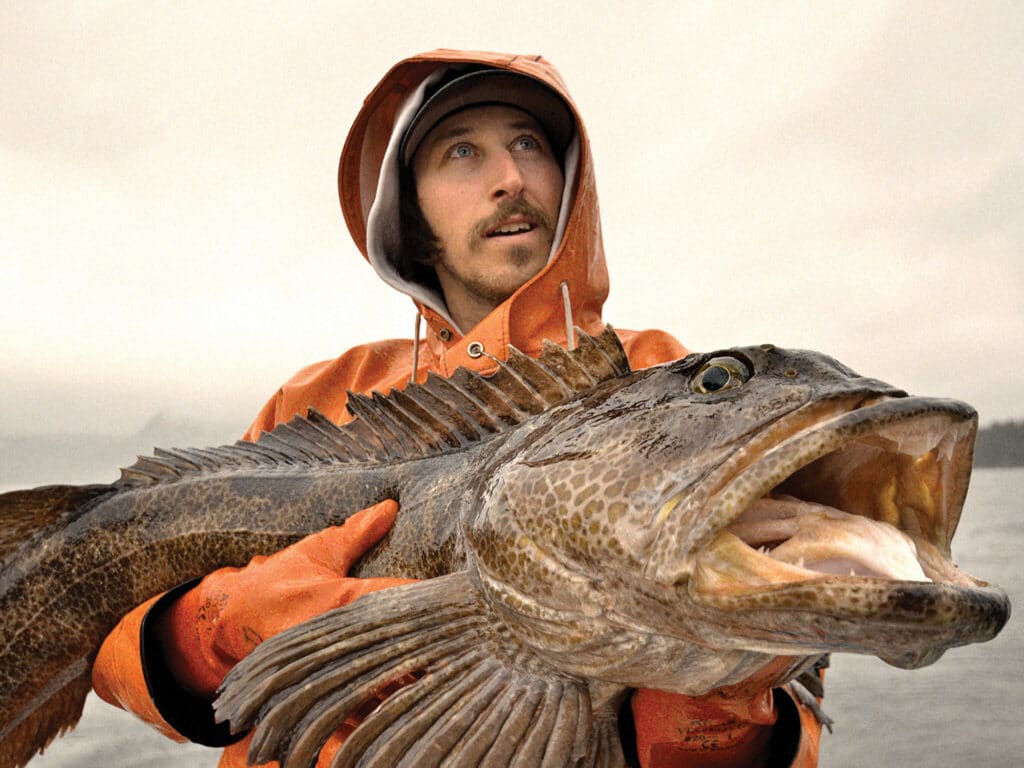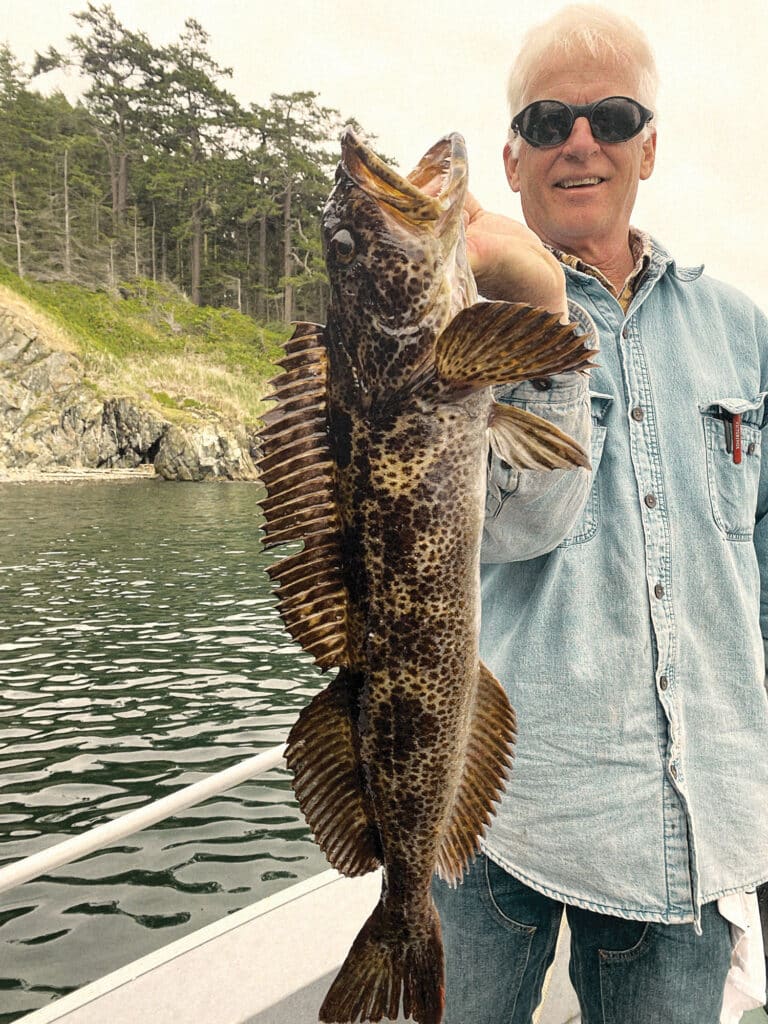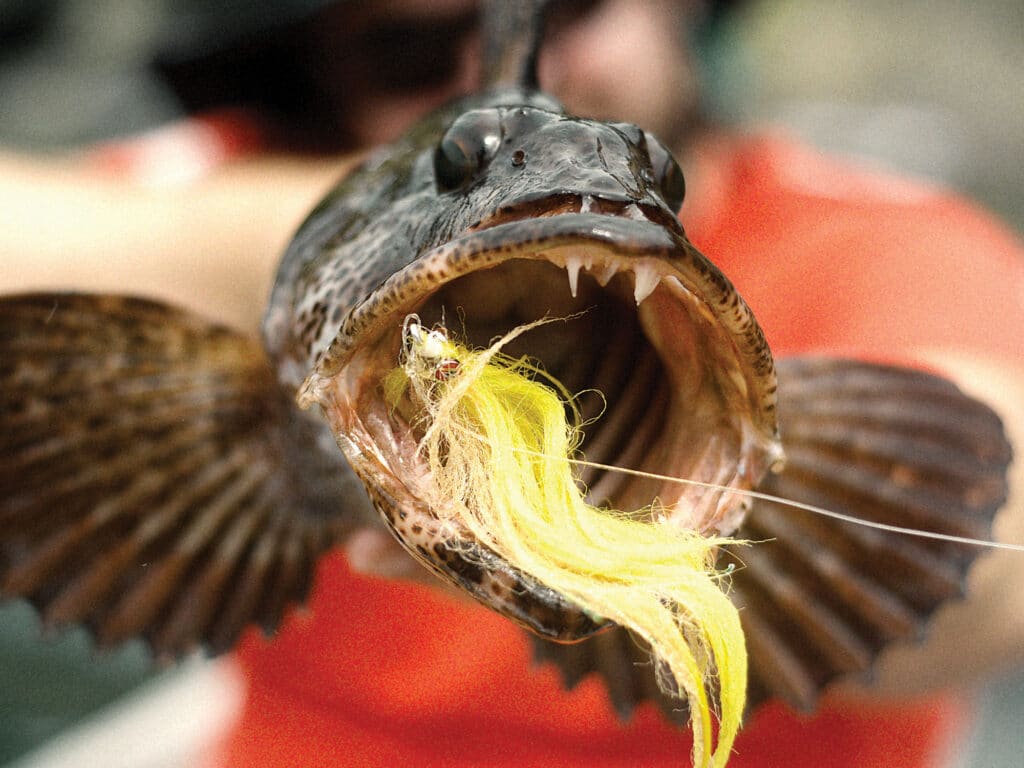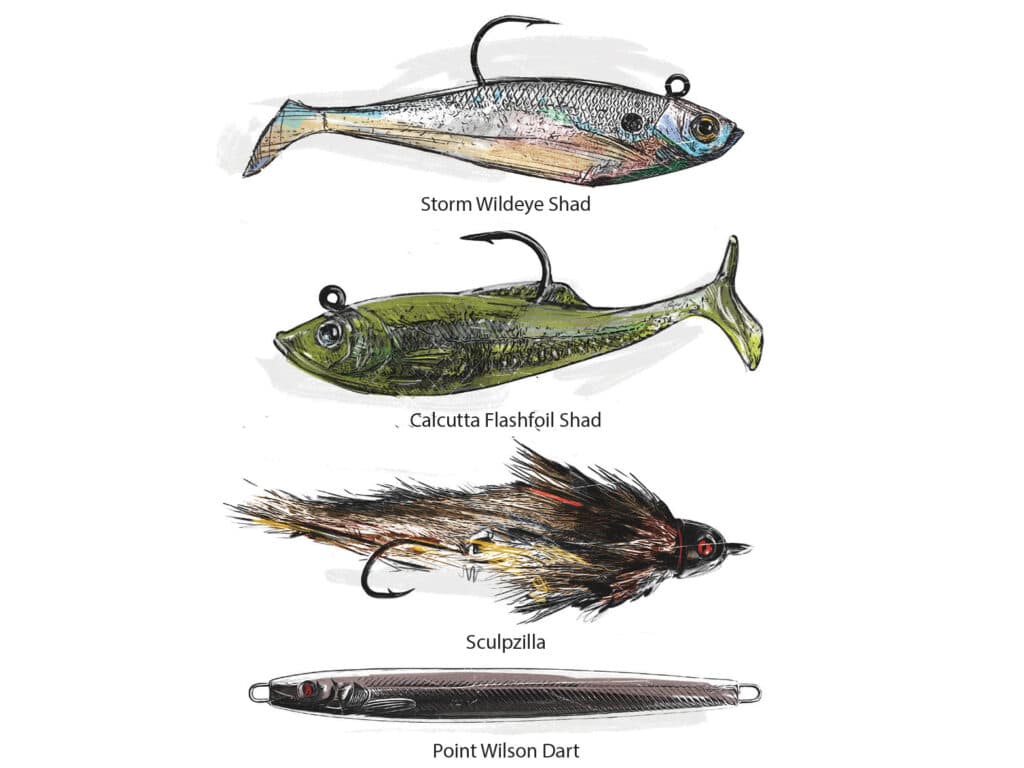
It looked like they were bass fishing: bow-mounted trolling motor, underhanded pitch casts tight to the shoreline, active retrieves. You could have been excused for guessing these dudes were bouncing tube jigs for ditch pickles were it not for our mutual location deep in the San Juan Islands of Washington’s Puget Sound. This was two decades ago, but I remember my dad and Uncle Keith practically scoffing as we drifted by. That’s not how you catch lingcod. You need to be way out in the deep channel, probing the rock piles—like us. And not catching fish—like us. Then I saw a lingcod hit the “bass boat’s” net. Twenty minutes later, another one. Limited out, these know-nothings who had just fished us under the table departed for the ramp. Equal parts irritated and intrigued, we motored over to the rocky point and kelp beds they’d been working. Good anglers are curious and learn new things. What happened next was nothing short of revelatory.
Neither Ling Nor Cod
Ophiodon elongatus, lingcod to you and me, is not at all related to the cod family, Gadidae, nor the several species called ling within it. Rather, it is a member of the greenling family, much like the kelp greenlings lingcod love to eat. That branch of the family tree isn’t far removed from the sculpins lingcod more closely resemble. But their closest counterpart in spirit would have to be muskellunge or barracuda—toothy, lurking apex predators hungry for large meals.
Like muskies and ’cudas, lingcod are highly versatile. They’ve been recorded at depths as great as 1,000 feet all the way to the shoreline. I swear that I’ve seen them break the surface in hot pursuit of a meal. They’ll eat just about anything they can fit in their fearsome mouths, with some favorites being rockfish, surf perch, greenling and octopus. They attack these snacks primarily via ambush, hiding among the rocks, reefs, wrecks, kelp beds and other structure they call home.
Many of the biggest lingcod are caught accidentally. Oftentimes an angler will hook a rockfish, greenling, flounder, or cod, even a small salmon or halibut, only to activate a large, dominant lingcod with those panic vibrations. That’s how my grandmother landed her Washington 40-pounder way back in the day. The key when this happens is to not fight the fish, lest it drop its prize. Simply crank slowly and steadily, and get the net ready. They’ll often refuse to surrender their meal all the way to the surface—completely unhooked.

So long as proper conditions exist, lingcod can be found from Alaska’s Aleutian chain down to Mexico’s Baja Peninsula, leagues offshore or in the breakers. Natural homebodies, lingcod typically spend most of their lives around whatever structure they found as juveniles, meaning populations exist in highly specific and localized areas. They spawn in winter, typically in shallow, rocky areas with heavy tidal current. Then the smaller males guard nests until larvae hatch in spring and disperse into kelp and eel-grass beds. Juveniles move back into hard structure and might incrementally shift deeper as they mature.
The reverence paid to the lingcod as a sport fish might be surpassed only by its esteem as table fare. Somewhere between halibut and true cod in texture, the meat is firm yet flaky, and sweet yet mild. But the greatest degree of culinary excitement might come from the shocking cobalt blue or turquoise green flesh present in about one of every five lingcod. You’ll know it when you catch one; the entire exterior of these special fish will be brightly tinted blue to green instead of the normal brown to
orange palette. Biologists have isolated the pigment biliverdin in this strange “smurf meat,” as it’s sometimes called, but have not proven why it occurs in such high levels in certain fish. The color vanishes when cooked, but it opens eyes on the cutting board.

Swim Shallow
Many anglers, including my father and uncle until that point 20 years ago, believe that fishing for lingcod is a deep, heavy, laborious affair. Captains from California to Alaska often run far and wide to submerged structure as deep as 500 feet. While that might be where you want to go looking for a truly monstrous sea wolf, you’d be cruising right past a lot of appropriate habitat to get there. And anyone can get sick of trying to keep their rig on the bottom in a few dozen fathoms across heavy current.
But as jetty anglers have long realized and boat-bound boys have begun to learn, lingcod are where the food and structure are. I once watched a surf perch fisherman land a big blue ling right under a ferry dock while I waited to board. Such locales open the door to much lighter tackle than would be possible with a pound of weight involved. Even cast-and-retrieve presentations are viable.
An advantage of this approach is that inshore lings do skew smaller than their deep-sea brethren. This is an important consideration in places like Puget Sound, which only allows harvest of one lingcod per day within a slot limit of 26 to 36 inches. That said, the biggest lingcod my dad and I ever landed—a terrifying female about 50 inches and pounds—was damn near visible when we hooked her in about 25 feet. You can go light nearshore, but not too light. The IGFA all-tackle world-record lingcod stands at 82 pounds, and even the little ones fight ferociously.
Light-Tackling Lingcod
A few years ago, some buddies and I returned to that same rocky shoreline armed only with 12-weights. It was not exceptionally practical but illustrative of lingcod’s shallow-water behavior. In two days, we all managed to land one ling on the fly, all in less than 15 feet of water as we held the boat just outside rollers smashing ashore. One friend even had one boil next to the boat as he picked up to recast—just like a muskie. We made sure to figure-eight boatside after that.
Read Next: Fishing for Lingcod With Large Saltwater Swimbaits

Back in my middle school days, Dad and I caught lings on almost every bait imaginable, from pile perch to surf perch, flounder, greenling, herring, sculpins, octopus and squid. (Note that regulations now generally disallow using any part of a “gamefish” for bait.) Most of those offerings present best on an 8-foot medium-heavy baitcasting or jigging rod with relatively thin 30-pound braid tied to a 3- to 10-ounce banana sinker, followed by 3 feet of 25-pound fluorocarbon tandem-snelled to 2/0 octopus hooks. Lingcod teeth don’t seem to sever leaders quite like pike, but it is important to be able to break off your rig in the snaggy structure and fast currents they prefer.
But lingcod are not exceptionally picky eaters and will readily take artificials. Finding the fish and getting something in front of them during the right point in the tidal flow is often a more difficult puzzle than lure selection. We’ve caught most of our baitless fish on butterfly, dart or diamond-style lead jigs resembling candlefish or herring. They drop quickly and flutter erratically, ready at all times to cast or jig. In certain shallow situations, larger and more realistic paddle-tail swimbaits and their ilk can send hungry lings into an absolute frenzy. White has always been a favorite, but green and blue perform as well. Honestly, I’m not convinced any color you could think of categorically wouldn’t work for these voracious predators.
A Rock-Pile Revelation
I stowed the halibut rod in exchange for a salmon stick terminating with a Point Wilson Dart as we approached the area that “bass boat” had recently vacated all those years ago. Dad and Uncle Keith kept jigging while I started casting. The current ripped us around the corner, changing the presentation angle quickly, and my offering landed beyond a dense bull kelp mat instead of the slot that I intended. As I cranked wildly to skip the dart over the floating fronds, a 10-pound blue rocket blew through the kelp forest suddenly, tossing my jig in the air.
“Like a bass with a frog,” Uncle Keith said, astonished as we tried to regain our composure.
On the next pass, a slot-limit lingcod broadsided the same dart as I retrieved it quickly through the slot between the rock and island. We were changed men. As soon as I got home, I went on the Cabela’s website to buy some giant muskie lures: inline spinners, spinnerbaits, and this new rubber fish concept people were starting to call swimbaits. Though jigging certainly remains in our arsenal, we rarely plunge past 100 feet anymore. Direct contact and visual takes from big, predatory fish put the inshore lingcod game on par with the greatest sport fishing on Earth.









